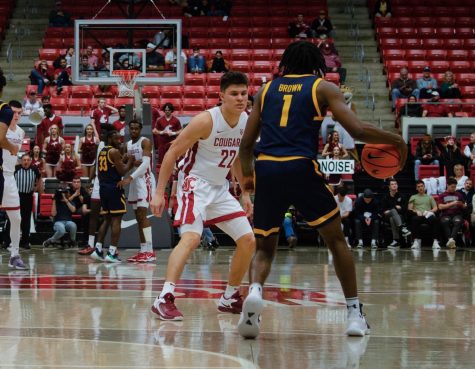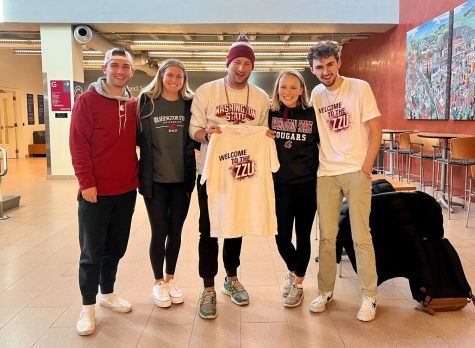Improving the system
October 29, 2013
In his introductory press conference in February of 2010, WSU Athletic Director Bill Moos said, “One thing we’re going to focus on right away is the culture – the mindset – of Cougars everywhere.”
That fall, WSU Athletics implemented the Drug Free Team Substance Abuse Prevention Program to change the culture for athletes on and off the field.
The Drug Free Team is an overarching departmental, program that supports the entire WSU Athletic Department.
As explained in its mission statement: “The purpose of the athletic department’s substance abuse prevention program, ‘Drug Free Team’, is to prevent abuse of drugs, alcohol and legal/illegal substances among student athletes by providing comprehensive, on-going, consistent education throughout the career of the student-athlete at WSU.”
The Drug Free Team program studied trends at WSU and was created when Moos took on his current role.
“When Bill Moos entered in the spring of 2010, we just transferred (the Drug Free Team) into his context. He was very much in favor of the program,” said Pam Bradetich, a senior associate director of Athletics and member of WSU’s Athletic Department.
Bradetich and the WSU Athletic department are aware issues are likely to arise and any athlete could headline a paper for a violation at any time. The goals of the Drug Free Team are to isolate such incidents and help provide the proper consequences and education for athletes who break team, departmental, or national rules.
“Drug Free Team has the message, the expectation and we’re asking for a commitment from the student-athlete because they’re not a student on campus, they’re a student-athlete and their experience is a little bit different and their health and performance is a priority to us,” she said.
Not all university athletic directors turn to a substance prevention and response program in order to support team development.
“We felt that for us to truly meet our vision of being a top team in our conference in all sports – or going to postseason – we needed to pay more attention to this,” said Bradetich. “We believe that sending the message to our student athletes about what best positions them to be the national champion, the conference champion – in postseason – would be to take a more comprehensive look.”
She said the Athletic Department sends the message that drug-free teams will achieve more success, which is supported by research.
The evidence surrounding success of “clean” athletic teams isn’t digestible from a numbers standpoint. However, the turn around WSU’s teams and coaching staffs have experienced in recent seasons show that distractions are limited and players are focused on their personal health and well-being. The teams lead as cohesive units on all of the university’s fields and courts.
“We have to have our social and behavioral factors managed to have success and we always want to be a part of that,” said Bradetich.
Through the Drug Free Team program, there are several ways to handle drug/alcohol abuse with WSU’s athletes. If there is a citation brought forth against one of WSU’s athletes, they will go through a set protocol developed by the Drug Free Team, and are also subject to discipline by their individual coaches.
In the event of an alcohol violation, drug violation, or reasonable suspicion, athletes will undergo a wellbeing check with Jerry Pastore, coordinator of Student-Athlete Wellbeing.
Pastore evaluates if the student-athlete needs to enter WSU’s counseling program or if they should be dismissed from the program. In the case of a drug violation, student-athletes will need to receive approval from the consulting committee to exit WSU’s counseling program.
However, the coaches can override the overarching response protocol.
“Bill Moos has authorized our coaches to be more strict and stringent than our three-strike policy,” said Bradetich.
If a WSU coach decides that the actions of a player indicate they don’t display a commitment to the team or wellbeing of the program, they can be cut.
This is a move that an observer might see from a head coach such as Mike Leach. He has publicly stated and written in his book, “Swing Your Sword,” there are specific actions that if a player commits, they can automatically be cut from the football team. One of the actions is taking illegal drugs.
This is a stance applauded by the Athletic Department and the Drug Free Team.
“We are very committed to our drug-free concept and Mike Leach is very supportive of what the department wide effort is,” said Bradetich.
The commitment and buy-in from coaches and athletes is exactly what Moos and the founding committee of the Drug Free Team looks for. Bradetich, Moos, WSU Athletics, and other members of the Drug Free team, believe they act as a resource.
“When (the coaches) have an issue they can find us,” said Bradetich. “So we are a resource for them and I think they value it. When we can get in with teams and do our educational programming we’ve had good feedback.”
WSU Athletics is also committed to involvement on College Hill, as the environment that surrounds the student athletes is just as important as the implemented policies in and around athletic facilities including Bohler Gym.
Leaders like Bradetich make presentations to the President Elson S. Floyd’s Alcohol Task Force and help make recommendations as to how to make the university safer and cleaner as a whole, even outside the athletic arena.
Consequences are a key part of the success of the Drug Free Team.
“Our national data shows that we are at or below our NCAA comparisons as far as use,” said Bradetich. “We mirror our campus statistically. What we have noticed is there has been a decline in citations both in alcohol and drugs.”
WSU athletes also have access to Twitter handles, social media groups, and web-based support sites to help ensure collaboration, education and help when faced with alcohol, drug or banned substance issues.
Moos also addresses WSU’s athletes each August concerning WSU’s Athletic policies, striving to make personal on-going connections with the athletes that make up all of WSU’s individual teams.
While Bradetich and Athletics don’t deny the possibility of cases in the future, they believe the overall goals of their programs are creating success, and also impacting not only the roughly 500 athletes on campus, but the 20,000 students who attend WSU.




















